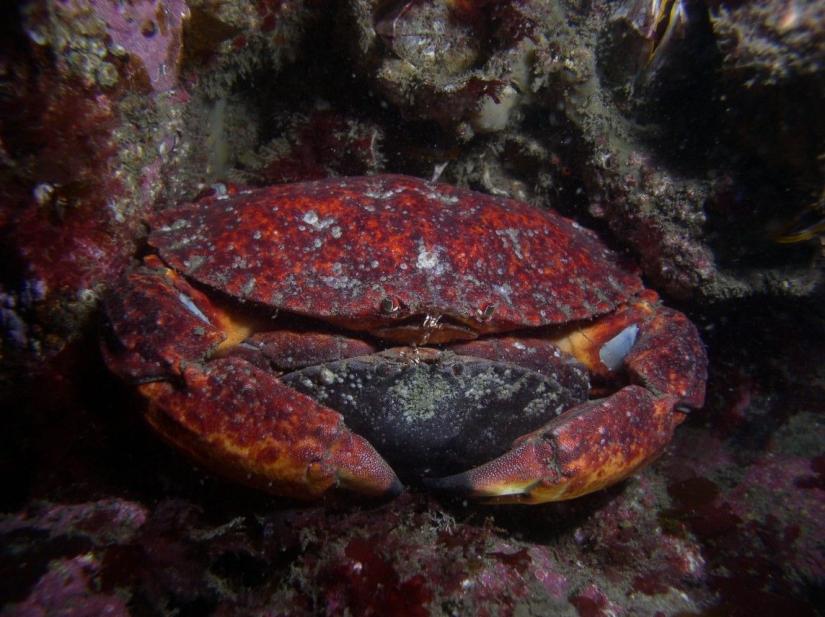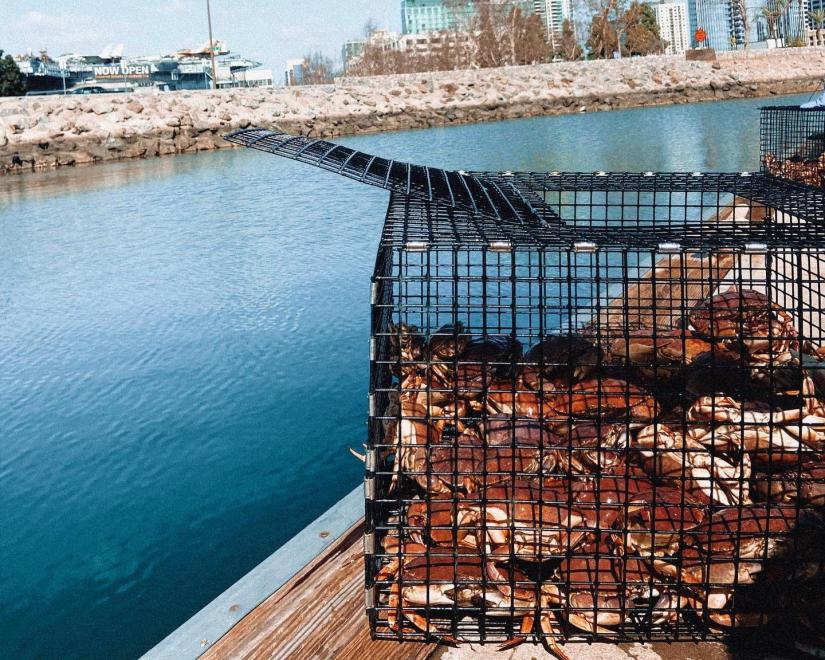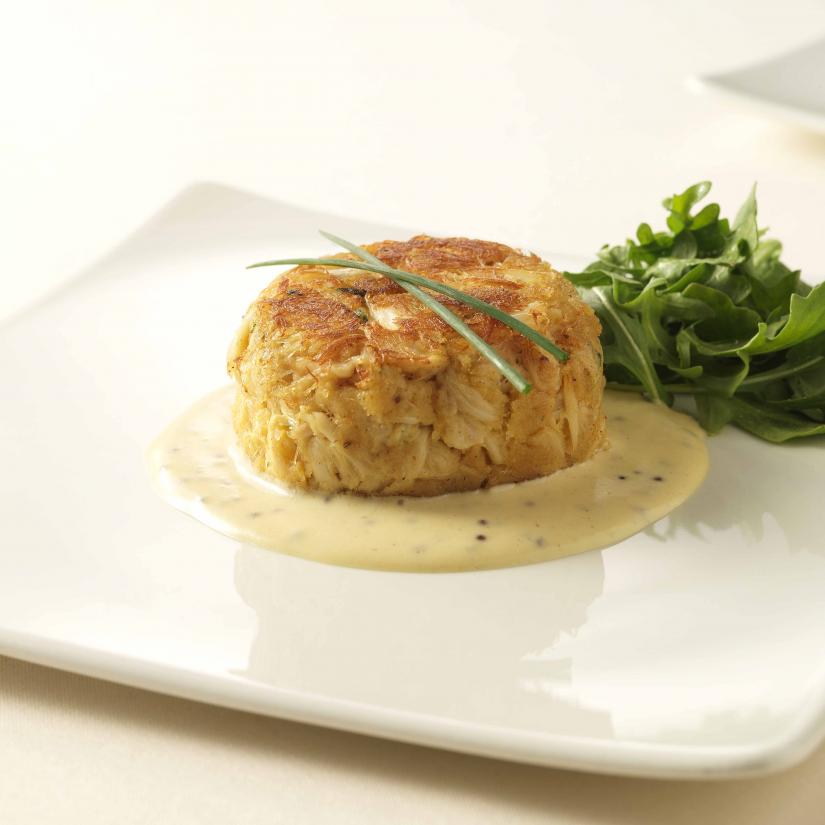Rock Crab
red: Cancer productus yellow: Metacarcinus anthonyii brown: Romaleon antennarius
The Science
THE SCIENCE
Crustacean chivalry: a male crab will often guard a female who is preparing to molt, by holding her under his abdomen.

Taxonomic description
- Distinguished by its broad carapaces (outer shell) and claws. [2]
- Males have slender abdomens and are larger than females, which have broad abdomens where they carry eggs. [1,2]
- These crabs grow to different sizes, but rarely exceed 20 cm (8”) in width. [1]
- The red rock crab is brick red in color, the brown crab is dark brown with red spots, the yellow crab is light brown to pale yellow with no spots. [2]
- All three used to be classified under the genus Cancer.
Distribution
- Found along California’s coastline, from Baja California to Washington. [2]
- Though the three species' ranges overlap, red rock crab is most common in northern California, the brown crab in central California and the yellow crab in southern California. [1]
Life history
- This crab grows in steps, molting the external shell at each step. [1]
- Mating occurs throughout the year, but peaks in Spring in California, and happens when females have soft shells just after molting. [1]
- Three months after mating, eggs are produced and then fertilized from a sperm packet left by the male during mating. The female carries the eggs for six to eight weeks until they hatch. [1]
- Larvae are planktonic and go through seven developmental molts before settling to the bottom as juveniles. [1]
Habitat
- Found mostly from the low intertidal to greater than 100 m (328 feet) depth. [1]
- Commonly found in rocky substrates, except for the yellow rock crab which lives on sandy bottoms. [1]
- Acts as predator and scavenger, using its claws to feed on shelled animals such as snails and clams. [1]
- As a juvenile, it is prey to commercial fishes and invertebrates like octopus. [2]
- Adults contribute to the diet of the threatened southern sea otter and other species. [2]
The Fishery
THE FISHERY
NorCal is missing out: 85-90% of the commercial rock crab landings are in southern California, because the Dungeness crab is the fishery focus in northern California.

Seasonal availability
- Year-round. [3]
Regulatory and managing authority
- As established by the Marine Life Management Act, the California Fish and Game Commission (CFGC) regulates the fishery, and the California Department of Fish and Wildlife (CDFW) manages this fishery in state waters. [9]
Gear type
- Baited rectangular traps made of welded mesh or collapsible plastic attached to a buoy. [3]
- Most commercial trapping occurs 27-73 m (90-240 ft) deep on open sandy bottoms or nearby rocky reefs. [1]
- Prior to 1991, only the trapped crabs’ claws were harvested; clawless crabs were returned to the ocean with the hope that claws would regenerate. Today, it is illegal to harvest only claws and most are landed alive for sale at fresh fish markets. [5]
Status of the fishery
- There is little to no information on the fishery in California.
- This fishery is one of the only major near shore fisheries with no restricted access and a low capital entry requirement; if these factors result in increased fishing pressure (high intensity for long periods of time), reductions in crab abundance and size may result. [3]
- The fishery is sustained by setting a minimum harvest on pre-reproductive crabs (<4.25 in. width at widest part of the body shell) and by including a 3.24 in escape ring on traps. [3]
- Beneficial future management efforts include: increased collaborative data collections, testing effects of a restricted access program in areas of high fishing intensity, gear modifications to reduce bycatch of other species. [3]
Potential ecosystem impacts
- No information is available for this particular fishery, but use of baited traps in general may lead to unintended catch, damage to seafloor in rough conditions, and entanglement of marine mammals in buoy lines. Solutions exist for most of these potential effects (e.g., release of bycatch, breakaway lines). [4]
The Seafood
THE SEAFOOD
For rock crabs 4-6” wide, figure on 8-10 crabs per person if just using the claw


Edible portions
- Claw meat is most commonly eaten, however the entire crab may be used in some recipes.
- Yield is very low, with a 1 pound crab yielding approximately 2.6 ounces of meat (0.16 pounds). [16]
Description of meat
- Claw meat is very sweet.
Culinary uses
- Crack the shell as you would an egg: be gentle to not destroy the contents. [6]
- Use the claws, or crack the entire shell & clear out guts, to cook in sauce or broth.
- Meat does not re-heat well, but freezes well so freeze until ready for use. [7]
- For information on how to prepare and cook rock crab, visit Ehow.com. [8]
- For a Vietnamese Tamarind crab recipe, visit vickypham.com. [10]
- For a corn and crab chowder recipe, visit littlebroken.com. [11]
Nutritional information
- Hard shell crab, steamed. [5]
Toxicity report
- No known contaminants.
Seasonal availability
- Available fresh year-round. [3]
References
[1] Parker, D.O. 2001. California's Living Marine Resources: A Status Report. Rock Crab. California Department of Fish and Wildlife. Web. https://nrm.dfg.ca.gov/FileHandler.ashx?DocumentID=34335&inline. Accessed 10 Sept 2020.
[2] Carroll, J.C., R.N. Winn. 1989. Species profiles: life histories and environmental requirements of coastal fishes and invertebrates (Pacific Southwest)--brown rock crab, red rock crab, and yellow crab. U.S. Fish Wildl. Serv. Biol. Rep. 82(11.117). U.S. Army Corps of Engineers, TR EL-82-4. 16 pp.
[3] California Department of Fish and Wildlife. 2019. Red, Yellow, and Brown Rock Crab, Cancer productus, Metacarcinus anthonyi, and Romaleon antennarium, Enhanced Status Report. Web. https://marinespecies.wildlife.ca.gov/red,-yellow,-and-brown-rock-crab/. Accesed 10 Sept 2020.
[4] Monterey Bay Aquarium Seafood Watch. n.d. Fishing and Farming Methods. Web. https://www.seafoodwatch.org/ocean-issues/fishing-and-farming-methods. Accessed 10 Sept 2020.
[5] Fatsecret. 2013. Steamed Hard Shell Crab. www.fatsecret.com/calories-nutrition/generic/crab-hard-shell-steamed
[6] Pacific Stone Crab. 2012. Truluck's La Jolla-Featuring Pacific Stone Crab. Vimeo. Web. http://vimeo.com/54756986. Accessed 10 Sept 2020.
[7] Shaw, H. 2013. Pacific Red & Rock Crabs: Cheap & Plentiful. Fish & Seafood Cooking. About.com. http://fishcooking.about.com/od/meetyourfish/p/Pacific_crab.htm.
[8] Amistaadt, A.J. How to cook red rock crab. eHow.http://www.ehow.com/how_5057747_cook-red-rock-crab.html
[9] Marine Life Management Act. n.d. California Department of Fish and Wildlife. Web. https://wildlife.ca.gov/Conservation/Marine/MLMA. Accessed 24 August 2020. Accessed 9 December 2020.
[10] Pham, V. Vicky Pham. 2010. Tamarind Crab (Cua Rang Me). Web. https://www.vickypham.com/blog/tamarind-crab-cua-rang-me. Accessed 2 February 2021.
[11] K. Little Broken. 2017. Crab and Corn Chowder. Web. https://www.littlebroken.com/fresh-corn-and-crab-chowder/. Accessed 2 February 2021.
[12] Bruner, C. iNaturalist. 2019. Digital image. Web. https://www.inaturalist.org/photos/31559673. Accessed 24 February 2021.
[13] Onthank, K. Invertebrates of the Salish Sea. Digital image. Web. https://inverts.wallawalla.edu/Arthropoda/Crustacea/Malacostraca/Eumala…. Accessed 24 February 2021.
[14] Tuna Harbor Dockside Market. Facebook. 2021. Digital image. Web. https://www.facebook.com/thdocksidemarket/photos/4220142528014998. Accessed 24 February 2021.
[15] Turner, T. flickr. 2013. Crab Cake. Digital image. Web. https://flickr.com/photos/bennyschophouse/8529544948. Accessed 24 February 2021.
[16] Clove Garden. Rock Crab - Pacific. Web. https://clovegarden.com/ingred/sf_cbrockz.html. Accessed 4 January 2022.



